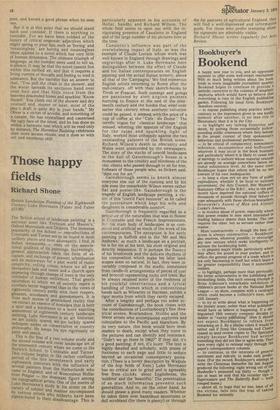Those happy fields
Richard Shone
British Landscape Painting of the Eighteenth Century Luke Herrmann (Faber and Faber E15.00) The 'British school of landscape painting' is a national asset like 'Fortnum and Mason s, Oxford Marmalade and Dickens. The immense popularity of the School — reproductions of Constable and Turner are to be found in most unlikely places and most abundantly, I find, in Indian restaurants — rests on the associational qualities of its paintings. Increasingly, general appreciation takes the form of escapism, and exchange of present urbanisation and its motorways for a past world of rustic simplicity, rolling vistas, where we all are Shropshire lads and lasses and a church spire appearing through clumps of trees is the only reminder of human settlement. That gentle squiredom to which we all secretly aspire is nowhere better suggested than in the views of eighteenth century parks with their reapers, gleaners, woodsmen and gamekeepers. It is from such scenes of generalised reality that we extract an essence of nostalgia that is both a spur and a hindrance to a more exacting assessment of eighteenth century landscape painting. Luke Herrmann is an art historian; we are luckily spared; we are luckily spared indulgent asides on conservation or country philosophy. He keeps his eye rigorously on paint and pencil. This is the first of a two volume study and the second volume will cover landscape art of the nineteenth century where we come to the Norwich School, to Constable and Turner. This volume begins in the rather confused period of the late seventeenth and early eighteenth centuries with the influence of several painters from the Netherlands who came to England, and of Wenceslaus Hollar from Prague — the dominant figure among the topographical artists. One of the merits of Luke Herrmann's study is his stress on the variety of subject and manner encompassed by various artists who hitherto have been pigeon-holed to their disadvantage. This is particularly apparent in his accounts of Holler, Sandby and Richard Wilson. The
whole field seems to open out with the invigorating presence of Canaletto in England and of the large number of his pictures here at the time.
Canaletto's influence was part of the overwhelming impact of Italy, as was the example of Claude Lorrain whose work was well known in England through drawings and engravings after it. Luke Herrmann here distinguishes between the effect of Claude and his Italian contemporaries on English painting and the actual Italian scenery, above all that of the 'Campagna.' We find numerous English artists swarming to Rome after the mid-century, off with their sketch-books to Tivoli or Frascati. Such comings and goings
are paralleled by alert English painters hurrying to France at the end of the nine
teenth century and the hordes that went over earlier this century when aesthetic salvation could be gained, it seemed, with the price of a cup of coffee at the 'Cafe ' du Dome '. The terrific vogue for classical landscape' that ensued, whetting the appetite of the English for the ruins and sparkling light of Italy, worked most unhappily against the two outstanding painters of the British scene.
Richard Wilson's death in obscurity and Wales went unrecorded by the newspapers. The story of the stacks of unsold landscapes in the hall of Gainsborough's house is a monument to the timidity and blindness of the chic clients who passed through to sit for him, forbears of those people who, as Sickert said, "dine out for art."
Gainsborough seems to knock almost everyone else out of the running and by his side even the remarkable Wilson seems rather flat and poster-like. Gainsborough is the tragedy-of English landscape painting, a vic tim of this "curs'd Face business" as he called the portraiture which kept his wife and daughters in considerable comfort.
Gainsborough is frequently regarded as a precursor of the naturalism that was to flower in Constable and the French Impressionists.
Bi:t his main body of landscapes is as composed and artificial as much of the work of his contemporaries. The exception is his early painting in Suffolk and in the 'Mr and Mrs Andrews,' as much a landscape as a portrait, he is for me at his best, his most original and directly responsive. It is perhaps the fluency of his brushwork and the delicate rhythms of
his composition which make his later landscapes seem so natural. In fact, they were invariably composed in the studio, sometime&
from candle-lit arrangements of pieces of coal and broccoli representing rocks and trees. But he always retained some of the freshness of his youthful observations and a lyrical handling of themes which in conventional hands such as Wheatley or Hayman, exhibit a rigor mortis from which they rarely escaped. After a lengthy and perhaps too sober account of Gainsborough, the book closes with the contributions of Loutherbourg's fine theatrical scenes, Rowlandson, Stubbs and the brave artists who accompanied explorers and colonialists to the Pacific and elsewhere. By its very nature, this book would bore most readers to death, except when they come to the pictures and can identify and reminisce. "Didn't we go there in 1962?" If they did, it's a good painting; if not, it's lousy. The text is highly detailed and scholarly, with posies of footnotes to each page and little to seduce beyond an occasional contemporary quotation. (There is a lovely description by Walpole of the hop fields of Kent.) Luke Herrmann has no critical axe to grind and is agreeably free from cliches about Englishness, the 'sublime' and the 'beautiful.' The presentation of so much information prevents such generalities. And so, on the other hand, he should please a good many readers. Whether he takes them over hazardous mountains or dull scrubland (for there is plenty) or through
the fat pastures of agricultural England, theY will find a well-mannered and informative guide. For those who prefer tramping alone, his signposts are admirably visible. Richard Shone writes regularly for Arts Review.


























 Previous page
Previous page